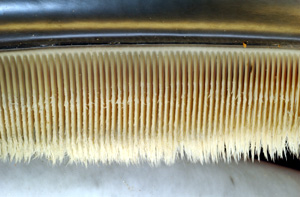Baleen
Baleen is a filter-feeding system inside the mouths of baleen whales. Unlike the teeth of other whales, baleen consists of a series of plates hanging from the upper jaw, made out of keratin, the same substance found in human nails and hair. These plates act as a sieve, allowing the whale to filter small plankton, krill, and small fish from seawater. Baleen plays a crucial role in the feeding strategy and ecological niche of baleen whales, distinguishing them significantly from their toothed counterparts in the Cetacea order.
Structure and Function[edit | edit source]
Baleen plates are arranged in parallel rows on either side of the whale's upper jaw, curving inwards. The inner edge of each plate is frayed into fine hairs that trap food particles as water is expelled through them. This unique feeding mechanism allows baleen whales to consume large quantities of small prey without the need for teeth to capture individual prey items.
The size, shape, and number of baleen plates vary among different species of baleen whales, reflecting differences in their feeding habits and preferred prey. For example, the Blue Whale, the largest animal on Earth, has relatively short, broad baleen plates that are efficient for filtering small shrimp-like creatures called krill. In contrast, the Right Whale has long, narrow plates for feeding on copepods, tiny crustaceans in dense swarms.
Evolution[edit | edit source]
The evolution of baleen is a subject of ongoing research and debate among scientists. It is believed that baleen whales evolved from toothed ancestors, with baleen gradually replacing teeth as these ancient whales adapted to filter feeding. This transition likely involved intermediate forms with both teeth and baleen, before the full development of the baleen system. Fossil evidence and genetic studies continue to provide insights into this evolutionary process, shedding light on how baleen whales became the efficient filter feeders we see today.
Conservation[edit | edit source]
Baleen whales face various threats, including whaling, entanglement in fishing gear, and climate change, which affects the availability of their planktonic prey. Conservation efforts are crucial to ensure the survival of these magnificent creatures and the ecosystems they support. International agreements and regulations, such as those enforced by the International Whaling Commission, aim to protect baleen whales from overexploitation and to promote the recovery of endangered populations.
Cultural Significance[edit | edit source]
Historically, baleen (also known as "whalebone") was highly valued for its flexibility and strength, used in a variety of applications including corsets, buggy whips, and umbrella ribs. Today, the cultural significance of baleen whales has shifted towards their role in ecotourism and as symbols of ocean conservation, inspiring efforts to protect the marine environment and its inhabitants.
Search WikiMD
Ad.Tired of being Overweight? Try W8MD's NYC physician weight loss.
Semaglutide (Ozempic / Wegovy and Tirzepatide (Mounjaro / Zepbound) available. Call 718 946 5500.
Advertise on WikiMD
|
WikiMD's Wellness Encyclopedia |
| Let Food Be Thy Medicine Medicine Thy Food - Hippocrates |
Translate this page: - East Asian
中文,
日本,
한국어,
South Asian
हिन्दी,
தமிழ்,
తెలుగు,
Urdu,
ಕನ್ನಡ,
Southeast Asian
Indonesian,
Vietnamese,
Thai,
မြန်မာဘာသာ,
বাংলা
European
español,
Deutsch,
français,
Greek,
português do Brasil,
polski,
română,
русский,
Nederlands,
norsk,
svenska,
suomi,
Italian
Middle Eastern & African
عربى,
Turkish,
Persian,
Hebrew,
Afrikaans,
isiZulu,
Kiswahili,
Other
Bulgarian,
Hungarian,
Czech,
Swedish,
മലയാളം,
मराठी,
ਪੰਜਾਬੀ,
ગુજરાતી,
Portuguese,
Ukrainian
Medical Disclaimer: WikiMD is not a substitute for professional medical advice. The information on WikiMD is provided as an information resource only, may be incorrect, outdated or misleading, and is not to be used or relied on for any diagnostic or treatment purposes. Please consult your health care provider before making any healthcare decisions or for guidance about a specific medical condition. WikiMD expressly disclaims responsibility, and shall have no liability, for any damages, loss, injury, or liability whatsoever suffered as a result of your reliance on the information contained in this site. By visiting this site you agree to the foregoing terms and conditions, which may from time to time be changed or supplemented by WikiMD. If you do not agree to the foregoing terms and conditions, you should not enter or use this site. See full disclaimer.
Credits:Most images are courtesy of Wikimedia commons, and templates, categories Wikipedia, licensed under CC BY SA or similar.
Contributors: Prab R. Tumpati, MD





